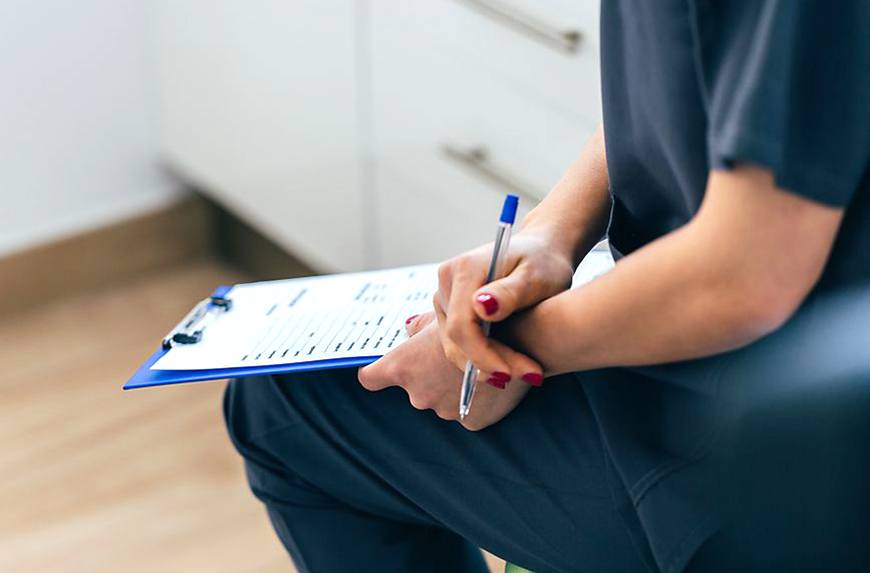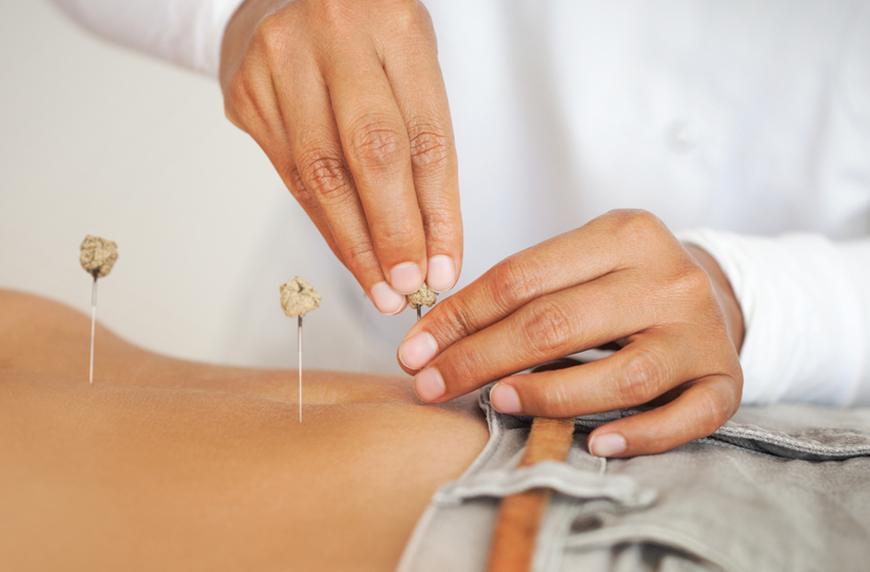Is Endometriosis the Most Under-Recognized Women’s Health Crisis of Our Time?
For women with this disease, tissue similar to the kind that normally lines the uterus grows on other parts of the body—like the ovaries, intestines, or bladder—and during their menstrual cycle, this layer can shed along with the uterine lining, often to excruciating effect. “[My diagnosis] made total sense,” Kate recalls. “For years, I had extremely painful periods, but I had never thought to consider endometriosis as a cause, nor was I that educated on the condition.”
In the four years since her diagnosis, Kate has been using hormonal birth control to manage her periods; she now menstruates just four times a year. She’s been seeing an acupuncturist for nutrition counseling and pain relief. (Because of the endometriosis, one of her ovaries has fused to her pelvic wall.) She’s about to have her third surgery to remove the rogue tissue from her body, and she’s pretty sure it won’t be the last.
There could also be further complications down the line. “I may have fertility issues, but since I'm not at a point in my life where I'm ready to have children, I remind myself that I need to cross that bridge when I come to it,” Kate says. “Until then, I can only continue to educate myself while focusing on my health and wellness and managing my pain.”
Kate’s not alone in her plight—she’s one of the 10 percent of women globally who are believed to be suffering from endometriosis. And that’s a conservative estimate, says Kathy Huang, MD. “My guess is the number’s probably higher than that,” proclaims the director of NYU Langone's Endometriosis Center. Like Kate, many women live with the condition for years before they realize that their gnarly periods aren’t just a matter of bad luck. In fact, it takes an average of a decade from the onset of symptoms for doctors to correctly diagnose endometriosis.

{{post.sponsorText}}
That may be about to change, thanks to the celebrities and wellness influencers who've been raising awareness of the disease by sharing their personal endometriosis experiences. (You’ve probably followed along with Lena Dunham’s story—after trying everything to ease her debilitating symptoms to no avail, she recently made the radical decision to undergo a hysterectomy.) But endometriosis’ turn in the spotlight also raises some alarming questions. Like, why does it take so long for this devastating disease to be properly diagnosed? What’s actually causing it in the first place? And is there anything more that can be done to help women heal, without having to resort to multiple surgeries or hormone therapy?
*Name has been changed.
Read on for everything you need to know about endometriosis.

Endometriosis: A growing epidemic, or just misdiagnosed for too long?
Every expert I interviewed for this story, conventional doctors and holistic practitioners alike, told me they’re treating more and more women who have been diagnosed with endometriosis. But, as many health pros are quick to point out, this doesn’t necessarily mean the disease itself is on the rise. Rather, it’s more likely that knowledge of the condition is growing, and women are increasingly asking their doctors to investigate symptoms they may have previously brushed off as unfortunate downsides to womanhood—painful sex, heavy periods with lots of cramping, bloating and digestive distress that get worse around menstruation.
But even though scores of women are waking up to the realities of endo, many more are still in the dark. “A lot of people are being told that their symptoms are normal and they’re just supposed to take Advil and deal with it,” says Dr. Huang.
"Without open and honest dialogue surrounding reproductive health, women will continue to miss out on the care they need and deserve—and that has to change.” —Piraye Yurttas Beim, CEO of Celmatix
Sarah, 32, was one of them. "I started showing symptoms at the age of 13 with my very first period," she recalls. "I bled for two weeks and had to see the pediatrician because I became ill from losing so much blood. I was put on iron pills." Five years, a birth control prescription, and multiple gynecologists later, Sarah finally underwent exploratory surgery and learned she had endometriosis. "[The doctor] cleared as much as he could but told me I’d probably have trouble getting pregnant when the time came—he was right," she says.
The kind of negative “period mythology” that Dr. Huang describes is deeply ingrained in our culture and highly dangerous, says women’s hormone expert and Well+Good Council member Alisa Vitti. “It starts early—the idea that getting your period is a 'curse,' you should expect it to be painful and miserable, and the best thing you can do is take medication,” she says. “And then ultimately, when you’re done making your babies, you should just get rid of [your uterus] because it’s more problematic than it’s worth. This is the conversation for women, start to finish.”
It also doesn’t help that, until the recent onset of the menstrual realness movement, women were largely conditioned to keep their period woes to themselves in the name of propriety. For Piraye Yurttas Beim, PhD, this climate of silence led to 15 years of suffering before she realized she had endometriosis. “One of the biggest obstacles getting in the way of better care is the stigma and shame that surround reproductive health in general,” says the CEO and founder of the genetic testing startup Celmatix. “When discussing symptoms is considered taboo, women are often reluctant to bring them up with their friends, family, or even their doctors. Without open and honest dialogue surrounding reproductive health, women will continue to miss out on the care they need and deserve—and that has to change.”

Why is it so hard to diagnose endometriosis, anyway?
Getting a doctor to take your symptoms seriously is only half the battle: Endometriosis is a notoriously difficult disease to spot, even when an MD is looking for it. Because it usually doesn’t show up on a sonogram or other radiologic imagery, it’s often only confirmed through invasive procedures. “A doctor needs to perform laparoscopic surgery on that patient and see endometrial tissue growing where it’s not supposed to,” says Dr. Beim. But, she adds, that’s a painful and expensive route. Therefore, some doctors opt to simply manage their patients’ symptoms through hormonal contraceptives and painkillers—without actually getting to the root of what’s causing their pain.
That’s simply unacceptable, proclaims Vitti. “Nowhere else do we have this experience in Western medicine,” she says. “In any other vertical [outside women's reproductive health], you’d have procedures and follow-up testing—the doctors would be all over whatever it is you have.” It's even more concerning when you consider that endometriosis is associated with some serious health issues. The disease is linked to an increased risk of ovarian cancer, while up to 50 percent of women with endometriosis are infertile.
Susan says endometriosis is now always on her mind—whereas before, it was never even on her radar.
Take Tracy, 41, who didn't learn she had endometriosis until she started trying to have a baby at age 37. "I was on the [birth control] pill since I was in college so I really did not have any pain," she recalls. "When I went off the pill to try to conceive is when all the problems started—painful bowel movements and sexual intercourse, lower back pain and abdominal pain. I had laparoscopic surgery and found out I had stage 4 endometriosis that destroyed my fallopian tubes and lowered my ovarian reserve... It has completely ruined my chances of ever having my own child."
These statistics are deeply worrying to 35-year-old Susan, who discovered she had endometriosis after a uterine fibroid operation last summer. “I had been seeing a fertility doctor for about seven months prior to the surgery, and while operating they discovered scar tissue consistent with endometriosis,” she says, adding she’s always had “horrible” periods but eased her symptoms over the years with birth control. “It can affect my ability to have children, which is extremely emotional. It can affect my health, with future surgeries looming and possible medication to slow the process.”
Though she does feel better since having her first surgery, Susan says endometriosis is now always on her mind—whereas before, it was never even on her radar.

The good news? Things are looking up for endometriosis sufferers
According to doctors, there’s nothing that can be done to prevent endometriosis from forming in the first place. “Ultimately, it is likely largely due to genetics,” says Suzanne Fenske, MD, endometriosis specialist at New York City’s Mount Sinai Health System.
The most commonly accepted theory holds that endometriosis is a product of "retrograde menstruation”—a phenomenon whereby menstrual blood flows backwards through the fallopian tubes and lands on the pelvic walls and organs, where the endometrial cells continue to grow. Many women experience retrograde bleeding, says Dr. Fenske, but it doesn’t result in endometriosis for everyone. “The difference in symptoms will be attributed to genetics or factors of the disease of which we are not yet aware,” she says.
That said, women are being presented with more options than ever to keep their existing endometriosis under control, beyond the usual tactics of hormone therapy, pain meds, and laparoscopic surgery to remove the displaced tissue. (A hysterectomy, like Lena Dunham’s, is considered a last resort. “Usually, a hysterectomy is reserved for situations where all other management options have failed,” Dr. Fenske says.)
“Factors such as nutrition, environmental [toxin] exposures, or even how we handle stress could impact the way endometriosis affects the body, and thus the resulting pain that it causes.” —Elizabeth Poynor, MD
For instance, at NYU Langone’s Endometriosis Center, patients have access to an acupuncturist, nutritionist, pelvic floor physical therapist, and even a psychiatrist. “Mental well-being is very important,” explains Dr. Huang. “When it’s a chronic disease that causes you to have a poor quality of life, we really have to help you emotionally and mentally as well.” (Indeed, those with chronic illness are up to 20 percent more likely to be depressed than the general population.) The center is also pioneering a new MRI diagnostics program that can find endometriosis non-surgically with 80 percent accuracy.
Women’s health specialist Elizabeth Poynor, MD, has endometriosis patients focus on reducing systemic inflammation, which she believes worsens symptoms. “Factors such as nutrition, environmental [toxin] exposures, or even how we handle stress could impact the way endometriosis affects the body, and thus the resulting pain that it causes,” she explains. “Things that may increase inflammation in our bodies may increase the effects [of] endometriosis.”
Women are also seeking out alternative health practitioners in an effort to soothe their symptoms. Vitti has seen countless patients’ endometriosis improve—or even disappear altogether—by following her signature FLO Living protocol, which brings hormones into balance through food, supplements, and lifestyle interventions. (Studies have indeed shown possible links between endometriosis and diet.)
"It is one million percent time to reevaluate the quality of care that women are getting for these chronic issues." —Alisa Vitti
Chinese medicine is another endometriosis treatment option that's growing in popularity, as women see how effective it can be in treating fertility and PMS. “In Chinese medicine, endometriosis is an expression of blood stagnation, which is a way of referring to dense tissue that can no longer disperse as it should,” says Chinese medicine doctor Jill Blakeway, founder of the YinOva Center in NYC. “Most of the patients who visit us experience relief from some combination of herbs, acupuncture, dietary changes, and lifestyle adjustments.”
Blakeway believes vaginal steaming is also highly effective, a (controversial) opinion shared by Ayurvedic expert Martha Soffer, founder of Surya Spa in Los Angeles. (Soffer’s other tips for dealing with endo? Rest during your period—that means no sex, no intense exercise, no stress—stay hydrated, and lay off the alcohol and sugar.)
And according to Vitti, we’re in a perfect position to amplify the conversation around endometriosis further, which will likely lead to even more new ways of approaching treatment. “Breaking down the [women’s health] taboos on social media has been hugely helpful, with all this period awareness that’s been happening over the past few years,” she says. “Now, we need to follow it up [by asking], ‘What are we doing to improve the health care piece of this equation?’ It is one million percent time to reevaluate the quality of care that women are getting for these chronic issues. Not only is it just long overdue, but the alternative options are so effective.” And, unlike birth control and other meds, they have very few (if any) side effects.

What to do if you think you have endometriosis
If there’s one thing endometriosis experts want all women to know, it’s that feminine pain is never normal, despite what we’ve all been conditioned to believe. And if your doctor tries to tell you that’s the case, you should probably break up with them. “I really encourage patients to continue to ask questions and seek a second opinion,” says Dr. Huang. She also stresses the importance of finding a specialist who can refer you to a diverse care team. “Otherwise, you’re only addressing one thing—and endometriosis manifests itself in many different ways.”
It’s also crucial to speak up about your endometriosis if you’re comfortable doing so. For one thing, says Dr. Beim, it will create further awareness around the disease, which helps attract research dollars. “One in ten women is estimated to have this disease, and yet researchers studying endometriosis received only $10 million in federal funding in 2016,” she says. “To put this into context, anthrax—which had zero cases in the U.S. in 2016—received $51 million that same year. That’s why we have to keep sharing our stories.” (To that end, Celmatix launched the #SaytheFword campaign in January 2018 to help women speak openly and honestly about fertility struggles, endometriosis-related and otherwise.)
You may also discover that open communication helps you find emotional solace—not to mention that you could put someone else on the path to healing. “I work with many women who also have endometriosis, but I wouldn’t have known that had I not gone through my own experience and decided to talk about it," says Susan. "It’s more common than most women know—you’re not alone.” And the more sufferers who help to bring endometriosis out of the shadows, the harder it will be to ignore.
If you're too embarrassed to talk to your doctor about intimate issues, you're not alone—check out the answers to 11 questions women are afraid to ask their OB/GYN. Another important health conversation you should be having? The one with your own body.
Loading More Posts...